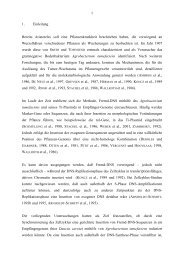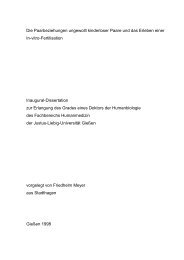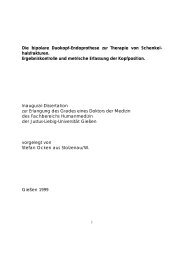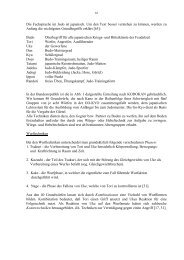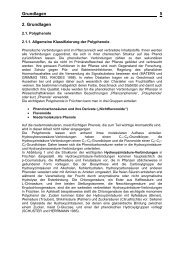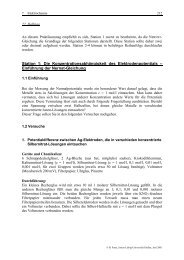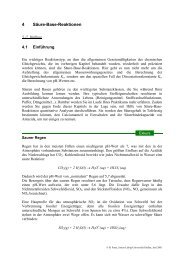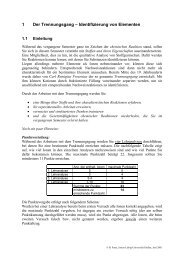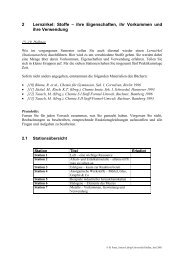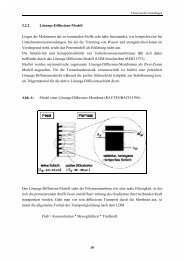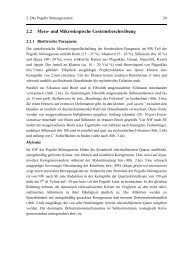Effects of diabaticity on fusion of heavy nuclei in the dinuclear model ...
Effects of diabaticity on fusion of heavy nuclei in the dinuclear model ...
Effects of diabaticity on fusion of heavy nuclei in the dinuclear model ...
You also want an ePaper? Increase the reach of your titles
YUMPU automatically turns print PDFs into web optimized ePapers that Google loves.
coupl<strong>in</strong>gs. Diabatic basis states ψ dynamical diab ≡ φα are def<strong>in</strong>ed [57] by <strong>the</strong> c<strong>on</strong>diti<strong>on</strong> that<br />
α<br />
<strong>the</strong> first-order dynamical coupl<strong>in</strong>g (2.9) vanishes. Introduc<strong>in</strong>g <strong>the</strong> decompositi<strong>on</strong> W = n<br />
wn(x, q), it is obta<strong>in</strong>ed [57]<br />
−(∂/∂qn) | φα >= 1<br />
2 [∆,wn] | φα >=<br />
as <strong>the</strong> <str<strong>on</strong>g>diabaticity</str<strong>on</strong>g> criteri<strong>on</strong> which is <strong>in</strong>dependent <str<strong>on</strong>g>of</str<strong>on</strong>g><br />
<br />
·∇+ (∇wn) 1<br />
2 (∆wn)<br />
<br />
·<br />
q n<br />
| φα > (2.12)<br />
·<br />
n and hence allows to def<strong>in</strong>e stati<strong>on</strong>ary<br />
q<br />
diabatic basis states. The relati<strong>on</strong> (2.12) ascribes <strong>the</strong> change <str<strong>on</strong>g>of</str<strong>on</strong>g> any diabatic state with q n to a<br />
collective displacement field ∇w n which scales all wave functi<strong>on</strong>s <strong>in</strong> <strong>the</strong> same way.<br />
The <str<strong>on</strong>g>diabaticity</str<strong>on</strong>g> criteri<strong>on</strong> (2.12) does not rigorously determ<strong>in</strong>e a diabatic representati<strong>on</strong><br />
because <strong>the</strong> velocity field is not uniquely def<strong>in</strong>ed. Therefore, <strong>the</strong> follow<strong>in</strong>g c<strong>on</strong>diti<strong>on</strong><br />
0 (2.13)<br />
is added. This c<strong>on</strong>diti<strong>on</strong> is appropriate whenever <strong>the</strong> collective velocities are sufficiently smaller<br />
than <strong>the</strong> Fermi velocity. The supplementary c<strong>on</strong>diti<strong>on</strong> (2.13) <strong>the</strong>n suggests to c<strong>on</strong>struct <strong>the</strong> di-<br />
abatic basis states from adiabatic states by avoid<strong>in</strong>g <strong>the</strong> dramatic changes <str<strong>on</strong>g>of</str<strong>on</strong>g> <strong>the</strong> wave functi<strong>on</strong>s<br />
near pseudo-cross<strong>in</strong>gs.<br />
2.2 C<strong>on</strong>structi<strong>on</strong> methods<br />
In atomic physics, a large variety <str<strong>on</strong>g>of</str<strong>on</strong>g> c<strong>on</strong>structi<strong>on</strong> methods for diabatic representati<strong>on</strong>s have<br />
been c<strong>on</strong>sidered [55, 61]. With<strong>in</strong> <strong>the</strong> TCSM, two methods for <strong>the</strong> c<strong>on</strong>structi<strong>on</strong> <str<strong>on</strong>g>of</str<strong>on</strong>g> diabatic<br />
states were developed [57] for central nucleus-nucleus collisi<strong>on</strong>s. The method <str<strong>on</strong>g>of</str<strong>on</strong>g> maximum<br />
overlap is based <strong>on</strong> <strong>the</strong> c<strong>on</strong>structi<strong>on</strong> <str<strong>on</strong>g>of</str<strong>on</strong>g> cross<strong>in</strong>gs <str<strong>on</strong>g>of</str<strong>on</strong>g> diabatic levels where pseudo-cross<strong>in</strong>gs occur<br />
<strong>in</strong> <strong>the</strong> adiabatic TCSM. The c<strong>on</strong>structi<strong>on</strong> <str<strong>on</strong>g>of</str<strong>on</strong>g> <strong>the</strong> diabatic states as a functi<strong>on</strong> <str<strong>on</strong>g>of</str<strong>on</strong>g> <strong>the</strong> relative<br />
distance starts from <strong>the</strong> separated <strong>nuclei</strong> where adiabatic and diabatic states co<strong>in</strong>cide. A<br />
diabatic state at a smaller relative distance is obta<strong>in</strong>ed from a l<strong>in</strong>ear comb<strong>in</strong>ati<strong>on</strong> <str<strong>on</strong>g>of</str<strong>on</strong>g> a few<br />
adiabatic states which maximizes <strong>the</strong> overlap with a diabatic state at somewhat larger relative<br />
distance. Us<strong>in</strong>g <strong>the</strong> so c<strong>on</strong>structed states, <strong>on</strong>e is able to obta<strong>in</strong> step by step <strong>the</strong> diabatic states<br />
for smaller relative distances. The method <str<strong>on</strong>g>of</str<strong>on</strong>g> maximum symmetry elim<strong>in</strong>ates <strong>the</strong> symmetry-<br />
22



